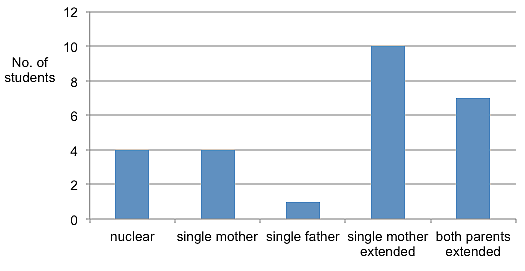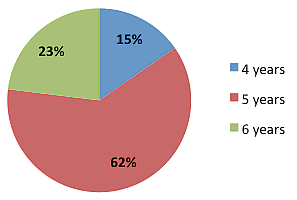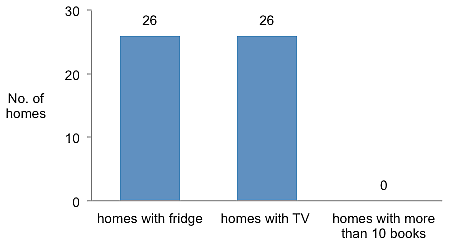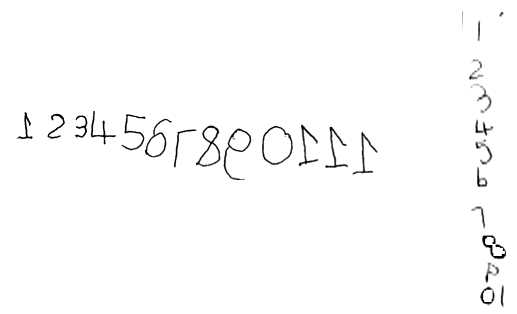
 |
Basic numeracy abilities of Xhosa Reception year students in South Africa: Language policy issues
Nosisi Nellie Feza
University of South Africa
Language in mathematics learning and teaching has a significant role in influencing performance. Literature on language in mathematics learning has evolved from language as a barrier to language as a cultural tool, and recently more research has argued for use of home language as an instructional tool in mathematics classrooms. However, the complexity of language is becoming another emerging challenge from bilingualism to multilingualism in different contexts. The need for access to mathematics knowledge has prompted debate about language policies that are inclusive of previously under-represented languages, especially in South Africa. This paper therefore extends this debate by exploring Reception class students' basic numeracy abilities and their numeracy levels to see if they speak in accord with the current language policy of South Africa and to assess whether the curriculum connects with the students. A concurrent mixed methods design was employed to investigate context and numeracy knowledge levels for a sample of 26 Reception class students from low socio-economic backgrounds. Both descriptive and thematic analyses were conducted to analyse the biographical, contextual and interview data collected. The findings reveal that the literacies experienced by students in their early ages of life are different from those perceived by policy makers, researchers and curriculum designers. This paper calls for more studies that are interdisciplinary as new identities and literacies are developing.
South African education policy asserts that Grade R (reception class) students should learn in their home languages (DoBE, 2014). Grade R is the first year of school in South Africa for 5 to 6 year old students and it is a bridging year between pre-school and formal schooling. Research supports this practice as Heugh (2012) indicated that more time spent by learners learning in their mother tongue has positive benefits for their performance. In view of such recommendations, this policy stipulation of mother tongue instruction for foundation phase (Grade R to 3) learning came to being in South Africa (DoBE, 2014). Mullis et al (2012) in The PIRLS 2011 International Results in Reading report revealed that students who take the international language test in their home languages perform better than those taking tests in a second or third language. These international findings demonstrate clearly that this language challenge does not belong solely to the South African context but to other countries. Nunan (2003) discovered that English as a universal language in the Asia-Pacific region created irregularities and inequities to effective language teaching as teachers were not proficient with English.
Internationally, there is a need to understand the complexity of language in mathematics learning and teaching. The demographics of the global community have changed due to increasing migration and immigration. Kiefer et al (2009) revealed that poor performance in mathematics is influenced by proficiency in academic English, hence they argued for development of academic language skills that are central to performing sophisticated mathematical tasks. This recommendation opens debate as they have not unpacked how this academic language can be developed amongst students. Research has to inform this community on how to address these challenges. Already code-switching is employed in different parts of the world (Salehmohamed et al., 2014; Selamat, 2014). What is not clear to date is the impact of such practice. Despite much support of the use of home language for learning mathematics, little is known about pre-school students' language skills in counting as they enter school.
The aim of this paper is to share linguistic numeracy levels demonstrated by Reception class students (Grade R) prior their formal engagement with learning in the Reception class. In this case, counting skills possessed by learners from their early experiences will be explored to see if the findings promote mother tongue learning. The paper also aims to explore the numeracy language abilities these students enter schools with. Therefore this paper aims to respond to the following research questions:
The biographical and context-based data was separated and entered into an Excel spreadsheet for quantitative analysis, aiming to obtain frequencies and groupings of data. Qualitative data from the video recordings of interviews was transcribed into a Word document, giving each line a number for analysis, while the field notes were entered separately, using the same format of numbering. The aim in separating the two sets of data was to analyse separately and then triangulate together at the coding level of the analysis. The typed data was then shared amongst two researchers for conducting individual analyses, as the two researchers agreed to write separate papers each with a different focus upon the data.
Each line was annotated with low inferences throughout both data sets. These low inferences were then grouped together in a table for each data set to make it easy to work with them. They were then colour coded according to similarities with the aim of finding patterns. Those low inferences that were not matching others were also highlighted using different colours and those that were contrasting some were also colour coded differently. Analytical memos were written summarising the observations and incorporating raw data to support the emerging patterns. The codes then started emerging when raw data was revisited and each researcher brought forward their separate codes. The two sets of codes from the two researchers were then triangulated through discussion, revisiting the raw data for empirical evidence and confirmation. Both researchers shared their analytical memos in strengthening the codes. Consensus codes were developed and were triangulated with the theory of learning trajectories for counting (Clements & Sarama, 2009, 2014). Analytical themes emerged from this analysis, and a thematic report will be presented in the next section.

Figure 1: Family structures of students
Figure 1 illustrates that the most common home structure for these students is extended families of single mothers. Extended families in the South African context are more prevalent amongst the black community due to the distribution of wealth that is skewed to the white community, which is also the minority (Holborn & Eddy, 2011). Families live together for survival as most youths are not working in South Africa and therefore family income can depend on the old age grant and child support grant. Figure 1 also shows a lower number of fathers who are present in the lives of these students compared to mothers. In this context most of these students depend on a government grant that is about R300 per month (about US$21 per month). If these students are fortunate enough to have a grandparent, the income the home receives will be increased by R1100 per month (about US$72 per month).
Figure 2 shows that at the time of the research most of the students in this study were aged five years, followed by aged six years and a few aged four years. According to South Africa's admission policy, only five to six year old students are supposed to be in the Reception class. In these schools, the Reception class sizes exceeded 45 students (average 47), which represented severe overcrowding in a Reception class, compared with the policy target of student to teacher ratio 30:1 (DoBE, 2011). In these classrooms, students had only one teacher with no assistants.

Figure 2: Reception class students' ages
As shown in Figure 3, no home had more than 10 books, and it is possible that the books that were there belonged to the schools, thus they were textbooks. The variables used in this graph are used in the TIMSS study to indicate how poor these homes are in the South African context. However, it is important to note that TV plays a significant role in developing students' language as they may spend most of their afternoons watching TV at home. As discussed in the findings below, these students' English language abilities develop prior to entering school, an indication of exposure to English language at home.

Figure 3: Students' home economic status
From this group of 12 students, one of them (Student A) counted 55 counters accurately, moving each as she counted them and at the end reporting that the counters numbered 55. In her counting she used English number names. When the researcher asked this student if she could count the same counters in her home language (Xhosa), she shook her head. Then the researcher asked her to count starting from "inye", which means one in the Xhosa language. The student then started object counting in Xhosa as "inye, zimbini, zintathu, zine, zintlanu, ntandathu, sixhenxe, sibhozo, lithoba, lishumi" ending at 10. Then the researcher asked her to continue counting. The response from the student was "andikwazi", meaning "I cannot". This student was also able to write numerals from one to 20 as shown in Figure 4, though missing 16. Note in Figure 4 that 17 is written as a mirror image rather than the correct 17, indicating a need for more practice in writing the number 7, also 5 is challenging for this student, although in 15 it is correctly written.

Figure 4: Student A numeral writing
Eight of these students followed suit with lowest counting being to 29 and the highest to 49 in English, with all three developmental levels achieved. Five of these eight students also struggled to understand counting in Xhosa until the hint of "inye" from the researcher; they then counted in Xhosa to 10 doing object counting and stating the total number of counters at the end as 10. One of the students counted in both languages as "inye one, zimbini two, zintathu three, zine four, zintlanu five, ntandathu six, sixhenxe seven, sibhozo eight, lithoba nine, lishumi 10". The remaining three students showed different levels; one could not even attempt to count in Xhosa; the second one tried but counted to 10 in English; then the third one tried but was only able to count to three ("inye, zimbini, zintathu") object counting. Only two, Student B and C, of these eight students were also able to write numbers from one to 10. Below is the evidence of their number writing.
 | |
| Figure 5: Student B numeral writing | Figure 6: Student C numeral writing |
The last three students were able to count from one to 23, with one student ending at 20 object counting. The two students were both able to count "ngo inye" meaning home language to 10 doing object counting and giving the total number of the 10 counters. One of these students, Student D, was able to write numbers from one to 10 and the other two were not able to write numbers. Below is evidence of the writing of one of the students.

Figure 7: Student D numeral writing
Only two of these students, Student E and F were able to write numbers. Others wrote alphabets, some zigzags and some only three numbers.

Figure 8: Student E numeral writing

Figure 9: Student F numeral writing
The second question asks: (2) Does the developmental progression observed in home language mediate counting concepts further? According to the findings of this research, the Xhosa number counting does not exceed 10 and for many students their Xhosa counting levels ended at one-to-one correspondence in the developmental progression. Some students used English as their referral language for more meaningful counting. The English development shown by the students also led to numeral documentation. Literature which reveals that language proficiency in the language of teaching increases mathematics performance assists in understanding these findings (Alexander, 1999; Anthony & Setati, 2008; Ball, 2010; Cummins, 1996; Heugh, 2002; Skutnabb-Kangas, 2000). These young students, coming from low socio-economic home backgrounds, have been exposed to numeracy that is communicated in English rather than in their mother tongue. It is clear that only English numerals are used in their community, hence it was easy for them to develop further in the pre-schools they attended before school. This paper therefore challenges the understanding of the current literacies in research and policy-making level. If the school sticks with the current language policy in developing these students, what will it be creating if the student goes back to the community that uses English numeracy language? This paper calls for more research that is interdisciplinary in studying new emerging linguistic identities in young learners for their relevant mathematical development. The findings of the paper point to a number of misalignments between the emerging student and language policy, the emerging student and curriculum expectations, and the developing literacies and research.
Adler, J. (2001). Teaching mathematics in multilingual classrooms. Dordrecht: Kluwer.
Alexander, N. (1999). English unassailable but unattainable: The dilemma of language policy in South African education. PRAESA Occasional Papers, 3. Cape Town: PRAESA.
Anthony, E. & Setati, M. (2007). Exploring the English proficiency-mathematical proficiency relationship in learners: An investigation using instructional English computer software. In J. H. Woo, H. C. Lew, K. S. Park & D. Y. Seo, (Eds.), Proceedings of the 31st Conference of the International Group for the Psychology of Mathematics Education, 2, pp. 217-224. Seoul: PME. http://hdl.handle.net/10539/2019
Ball, J. (2010). Enhancing learning of children from diverse language backgrounds: Mother tongue-based bilingual or multilingual education in the early years. Geneva, Switzerland: UNESCO. http://unesdoc.unesco.org/images/0021/002122/212270e.pdf
Barwell, R. (2002). Understanding EAL issues in mathematics. In C. Leung (Ed.), Language and additional/second language issues for school education. (pp. 69-80). Watford: NALDIC. http://www.naldic.org.uk/eal-publications-resources/Shop/shop-products/b4.html
Bialystock, E. (2006). Bilingual in development: Language, literacy and cognition. Cambridge: Cambridge University Press.
Beal, C. R., Adams, N. M. & Cohen, P. R. (2010). Reading proficiency and mathematics problem solving by high school English language learners. Urban Education, 45(1), 58-74. http://dx.doi.org/10.1177/0042085909352143
Botes, H. & Mji, A. (2010). Language diversity in the mathematics classroom: Does a learner companion make a difference? South African Journal of Education, 30(1), 123-130. http://www.ajol.info/index.php/saje/article/view/52606
Brown, C. R., Cady, J. A. & Lubinski, C. A. (2011). The effects of poverty and language on mathematics achievement for English language learners. New York: Springer.
Carroll, J. B. (Ed.) (1997) [1956]. Language, thought, and reality: Selected writings of Benjamin Lee Whorf. Cambridge, Mass.: Technology Press of Massachusetts Institute of Technology. http://www.jstor.org/stable/j.ctt5hhbx2
Clements, D. H. & Sarama, J. (2009). Learning and teaching early math: The learning trajectories approach. New York: Routledge.
Clements, D. H. & Sarama, J. (2014). Learning and teaching early math: The learning trajectories approach (2nd edition). New York: Routledge.
Creswell, J. W. (2003). Research design: Qualitative, quantitative, and mixed methods approaches (2nd edition). California: SAGE.
Cummins, J. (1996). Negotiating identities: Education for empowerment. Covina: California Association for Bilingual Education.
Department of Education (1997). Language in education policy. http://www.education.gov.za/Resources/Policies.aspx [file LanguageEducationPolicy1997.pdf]
Department of Education (2002). Revised National Curriculum Statement Overview: Grades R-9. Pretoria: Government Printers. http://www.education.gov.za/Portals/0/CD/GET/doc/overview.pdf?ver=2006-11-21-100143-000
Department of Basic Education (2011). Universal Access to Grade R: Policy Framework. http://www.thutong.doe.gov.za/ResourceDownload.aspx?id=47575&userid=-1
Department of Basic Education (2014). National Curriculum Statement: Curriculum Assessment Policy. Foundation Phase Grades R to 3. http://www.education.gov.za/LinkClick.aspx?fileticket=%2BrzCcDZUb5k%3D&tabid
Essien, A. A. & Setati, M. (2007). Exploring the English proficiency-mathematical proficiency relationship in learners: An investigation using instructional English computer software. In J. H. Woo, H. C. Lew, K. S. Park & D. Y. Seo (Eds.), Proceedings of the 31st Conference of the International Group for the Psychology of Mathematics Education, 2, 217-224. Seoul: PME. [see http://wiredspace.wits.ac.za/handle/10539/2019]
Feza-Piyose, N. (2012). Language - a cultural capital for conceptualizing mathematics knowledge. International Electronic Journal of Mathematics Education, 7(2), 62-79. http://iejme.com/makale/288
Feza, N. N. (2013). Inequities and lack of professionalisation of early childhood development practice hinder opportunities for mathematics stimulation and realisation of South African policy on quality education for all. International Journal of Inclusive Education, 18(9), 888-902. http://dx.doi.org/10.1080/13603116.2013.855266
Feza, N. N. (2015). Teaching 5- and 6-year-olds to count: Knowledge of South African educators. Early Childhood Education Journal, 44(5), 483-489. http://dx.doi.org/10.1007/s10643-015-0736-z
Henry, D. L., Baltes, B. & Nistor, N. (2014). Examining the relationship between math scores and English language proficiency. Journal of Educational Research and Practice, 4(1), 11-29. http://scholarworks.waldenu.edu/jerap/vol4/iss1/2/
Heugh, K. (2012). The case against bilingual and multilingual education in South Africa. Occasional Paper 6: PRAESA. http://www.praesa.org.za/files/2012/07/Paper6.pdf
Kieffer, M. J., Lesaux, N. K., Rivera, M. & Francis, D. J. (2009). Accommodations for English language learners taking large scale assessments: A meta-analysis on effectiveness and validity. Review of Educational Research, 79(3), 1168-1202. http://dx.doi.org/10.3102/0034654309332490
Klass, A. & Trudell, B. (2011). Effective literacy programmes and independent reading in African contexts. Language Matters, 42(1), 22-38. http://dx.doi.org/10.1080/10228195.2011.569739
Mbatha, T. (2014). Experiences of foundation phase teachers qualified in a dual medium programme. Per Linguam, 30(2), 37-50. http://dx.doi.org/10.5785/30-2-564
Mullis, I. V. S., Martin, M. O., Foy, P. & Drucker, K. T. (2012). PIRLS 2011 International Results in Reading. TIMSS & PIRLS International Study Center: Lynch School of Education Boston College. http://timssandpirls.bc.edu/pirls2011/international-results-pirls.html
Nunan, D. (2003). The impact of English as a global language on educational policies and practices in the Asia-Pacific region. TESOL Quarterly, 37(4), 589-613. http://dx.doi.org/10.2307/3588214
Salehmohamed, A. & Rowland, T. (2014). Whole-class interactions and code-switching in secondary mathematics teaching in Mauritius. Mathematics Education Research Journal, 26(3), 555-577. http://dx.doi.org/10.1007/s13394-013-0103-6
Selamat, J. T. (2014). Code switching in the Malaysian ESL classroom. Unpublished Master of Arts thesis, University of Otago. http://hdl.handle.net/10523/4909
Setati, M. & Adler, J. (2001). Between languages and discourses: Language practices in primary multilingual mathematics classrooms in South Africa. Educational Studies in Mathematics, 43(3), 243-269. http://dx.doi.org/10.1023/A:1011996002062
Setati, M. (2005). Mathematics education and language: Policy, research and practice in multilingual South Africa. In R. Vithal, J. Adler & C. Keifel (Eds.), Researching mathematics education in South Africa: Perspectives, practices and possibilities. Cape Town: HSRC Press.
Setati, M. (2008). Access to mathematics versus access to the language of power: The struggle in multilingual mathematics classrooms. South African Journal of Education, 28(1), 103-116. http://www.sajournalofeducation.co.za/index.php/saje/article/view/150/99
Skutnabb-Kangas, T. (2000). Linguistic genocide in education -- or worldwide diversity and human rights? London: Taylor & Francis.
Spaull, N. & Kotze, J. (2014). Starting behind and staying behind in South Africa: The case of insurmountable learning deficits in mathematics. Stellenbosch Economic Working Papers. http://www.ekon.sun.ac.za/wpapers/2014/wp272014/wp-27-2014.pdf
Vygotsky, L. (1978). Mind in society: The development of higher psychological process. Cambridge, MA: Harvard University Press.
Winsor, M. S. (2007). Bridging the language barrier in mathematics. Mathematics Teacher, 101(5), 372-378. http://eric.ed.gov/?id=EJ781012
| Author: Nosisi Nellie Feza is an Associate Professor in the College of Graduate Studies, University of South Africa, where she is a Head of the Institute for Science and Technology Education. She has obtained a PhD in Mathematics Education from the State University of New York at Buffalo, New York as a Fulbright scholar. She received a Diversity Scholar Award from the National Center for Institutional Diversity in Michigan in 2009. Her research interests are early childhood mathematics stimulation and teacher development and cultural influence in learning mathematics in students of African descent. Email: fezann@unisa.ac.za Websites: http://www.unisa.ac.za/default.asp?Cmd=ViewContent&ContentID=97778 https://sites.google.com/site/nosisifeza/classroom-news Please cite as: Feza, N. N. (2016). Basic numeracy abilities of Xhosa Reception year students in South Africa: Language policy issues. Issues in Educational Research, 26(4), 576-591. http://www.iier.org.au/iier26/feza.html |